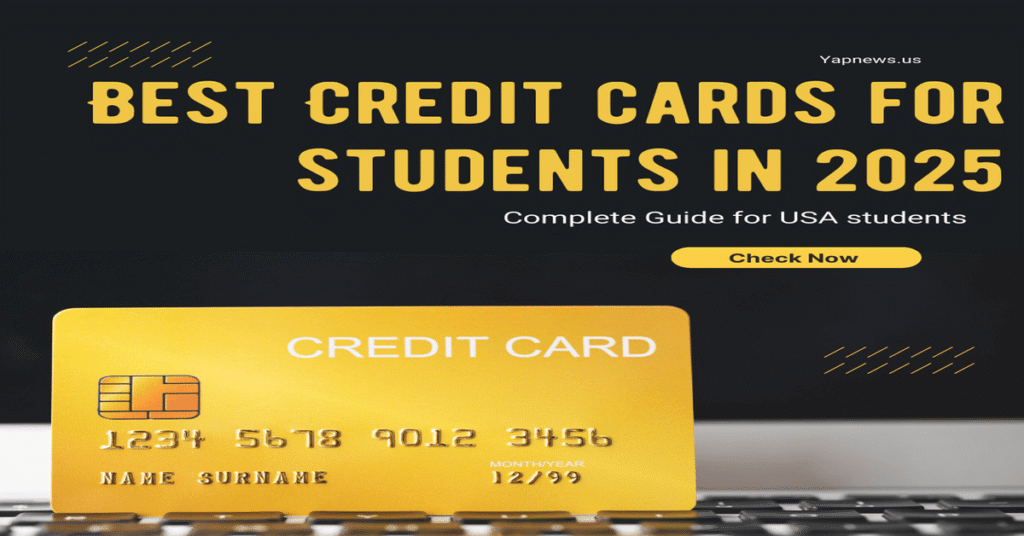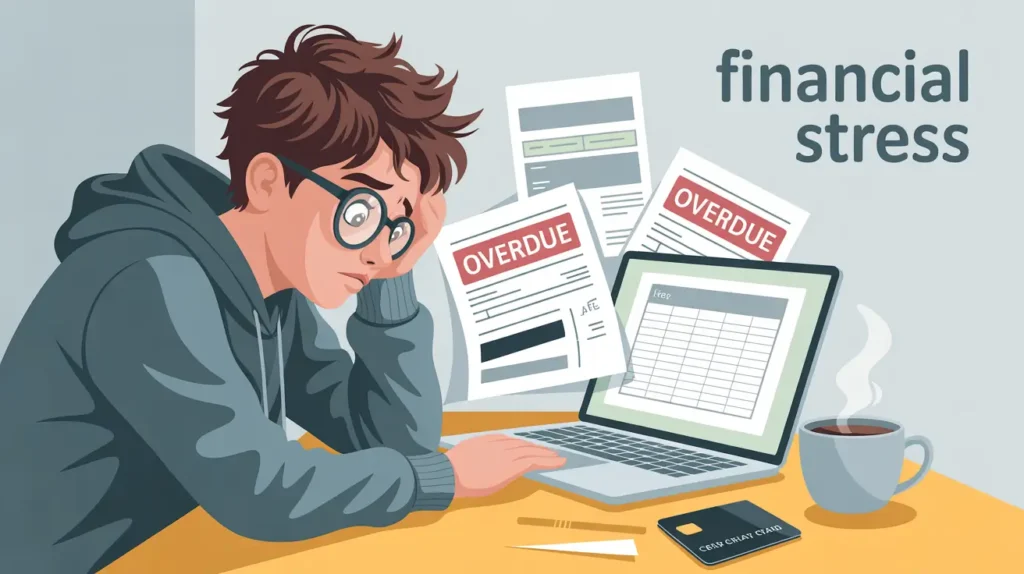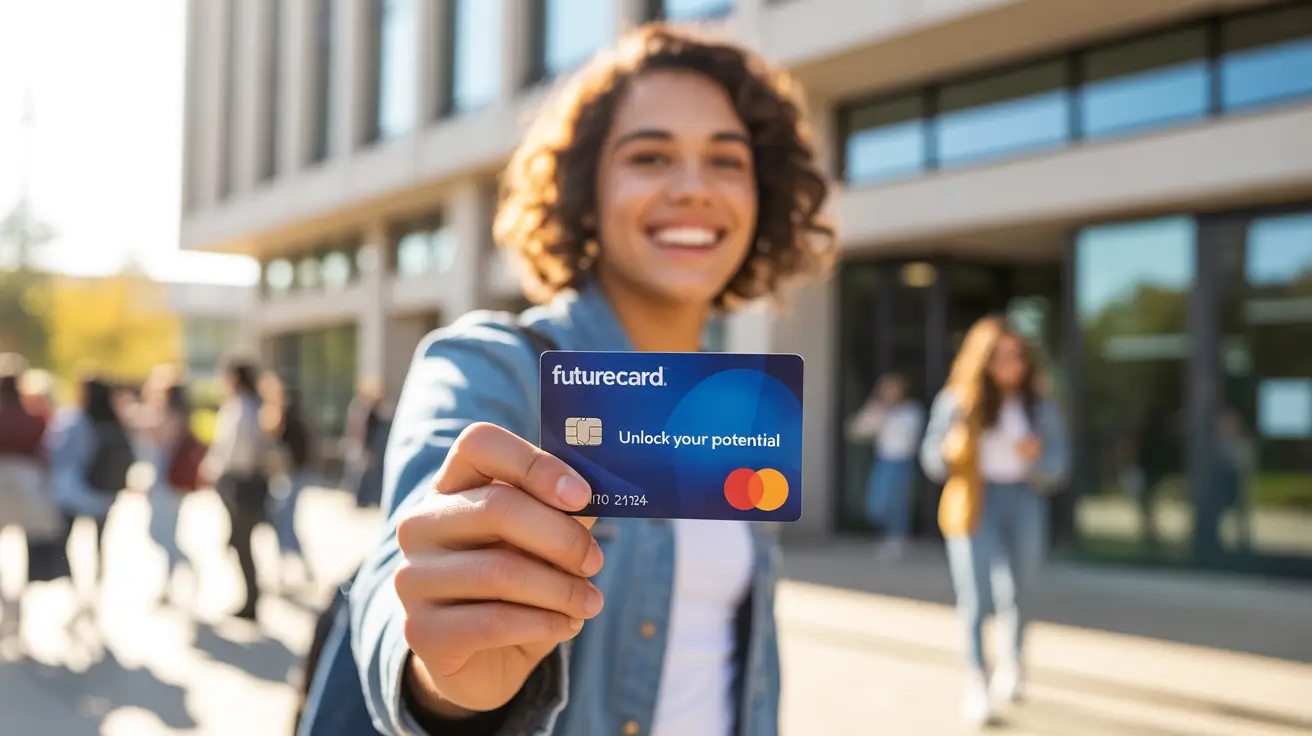Introduction
Why Credit Cards Are Important for Students in 2025 College life in the USA is fun — freedom, different culture, and lots of responsibilities. But with independence comes the big existential threat: money. Student credit cards are where this game changes.
Consider a credit card as something beyond a piece of plastic — it paves the way for you to create a credit history, earn rewards and learn how to manage money responsibly. Banks and card issuers are offering even greater options in 2025 that fit the needs of students.
But which card should you get? Do you want cashback, travel rewards, or to just point yourself in the direction of the safest “no annual fee” option? In this no-nonsense guide, we’ll deconstruct everything in human-style, through real-life examples, so you won’t find yourself floating around in techno-jargon’s space.
What Is a Good Student Credtt Card?
But before we dive in, a quick look at what to look for in a student model. For Best Credit cards for students in 2025
1. No Annual fee:
You’re just getting started — why pay more? A best student credit card in 2025 will not have an annual fee.
2. Rewards Program:
Lots of cards now come with cashback on dining, groceries or online shopping. Just imagine if you earned 5% back in free money on your daily morning $5 Starbucks coffee run!
3. Low Interest Rates (APR):
While you should always be punctual, you might find yourself in a jam from time to time. You stay away from crazy interest charges with a lower APR card.
4. Credit Building Features:
Some of the cards listed below go directly to all three credit bureaus (Experian, Equifax, TransUnion). It enables you to develop a positive credit record early.
5. Perks for Students
In 2025, most issuers throw in the following perks for free:
- Free trials of Spotify or Netflix
- Discounts on textbooks
- Travel privileges for exchange programs
Best Credit Cards For Students In 2025

The Best Credit Cards For Student’s in America 2025
Here’s the revised, 2025 list of the best student credit cards, based on rewards, cost, and word-of-mouth among students.
1. Discover it® Student Cash Back – The Best Overall
- Annual Fee:** \$0
- Rewards:** 5% cashback on rotating categories (so, e.g., Amazon, grocery stores, gas stations).
- Why Students Like It:** Discover doubles your cashback at the end of the first year.
- Example: John, a sophomore in California, spends \$100 a month on Amazon and groceries. Taking into consideration 5% cashback and the fact that Discover Match, he saves *\$120 in one year only.
2. Chase Freedom® Student Credit Card – Ideal for Beginners
- Annual Fee:** \$0
- Benefits: Flat 1% cash back on every purchase.
- Bonus:** \$50 signup bonus with first purchase.
- Example: Sarah, a first-year student majoring in engineering, received this card. She budgets about \$250 a month for food and travel. By the end of the year, she’s received \$30 cashback + \$50 bonus = \$80 in total — not bad for a beginner card.
3. Capital One SavorOne Student Cash Rewards – Best for Food Lovers
- Annual Fee:** \$0
- Rewards: 3% back at dining, streaming services, supermarkets and on entertainment.
- 1% on everything else.
- Real-Life Use: Raj, an international student from India studying in New York, spends \$200 per month on dining + Netflix + groceries. He receives \$6/month back =\$72/year. Small but sweet.
4. Bank of America® Travel Rewards Student – Best for Travelers wxDefault
- Annual Fee: \$0
- Rewards: 1.5 points per dollar spent on purchases can be used for flights, hotels or Uber rides.
- Real Life Use: Emma goes on study abroad programs and uses this card to book flights. In just one semester, she earned 15,000 points = \$150 in free travel credits!
5. Deserve® EDU Mastercard for Students – Best for International Students
- Annual Fee: \$0
- Rewards: You\’ll receive 1% cashback on all your spending.
- Cool Feature: Does not require the borrower to have a Social Security Number to be approved (ideal for international students).
- Sample: Arjun from India got Deserve EDU approval without SSN. He was spending \$500/month on living and was getting back *\$60 in a year. * Plus, he received *1 year of free Amazon Prime Student membership.
Case Study 1:
- Case study: Emma – Building Credit with Discover it® Student Cash Back
- Background: Emma, a 19-year-old freshman at University of California.
- Goal: she needed to build credit.
- How: Emma used Discover it® Student Cash Back for groceries and enabled auto-pay.
- Result : The credit score grew from 0 to 720 in just 12 months, and Emma was able to get student house dwelling without needing a co-signer.
- Lesson: start small, pay on time, and let your score thrive.
Case Study 2:
- Case Study : Jason – Travel Rewards with Chase Freedom Student
- Background: Jason, 21 years old, studying in NYU.
- Goal: He dreamt about traveling cheaply.
- Action: Jason used Chase Freedom Student for flights and Uber and then collected the points.
- Result: He saved S350 on flights and upgraded to Chase Sapphire Preferred®. Jason got his credit score to 740.
- Lesson: consider rewards cards – they can fuel your way of life if you do not go wild.
Case Study 3:
- Case Study : Priya – Responsible Budgeting with Capital One Quicksilver Student
- Background: Priya is an international student from India who studied at the University of Michigan.
- Goal: establish responsible spending habits.
- Action: used Quicksilver Student for dining and textbooks and monitored the spending.
- Results: Priya’s credit score grew from 0 to 735 in two years, and she earned $600 in cash back. Priya received a low-interest car loan.
- Lesson: even an Indian student can quickly establish U.S. credit six
Mistakes Students Should Avoid with Credit Cards

1. Spending More Than You Can Afford
- Credit card is a kind of “mini loan”. If you do not repay the full balance every month, then **interest charges** are levied which can be up to 20%–30% annually.
- Example: If a student buys a phone worth $500 and pays only $50, then interest will be charged every month on the remaining amount. In the end, the actual price of the phone can be $650–$700.
2. Ignoring Due Dates
- If payment is not made on the due date, a late fee (\$25–\$40) is charged and the credit score which is useful in future may also be reduced. If the score goes down once, there can be problems in future loan, apartment rent, or job background check.
- Example: Emily (University student) missed the due date once, after which her credit score fell by 30 points. Next semester when she wanted to take a car loan, she had to pay high interest rate.
3. Applying for Too Many Cards
- Every time you apply for a new credit card, a **hard inquiry** is applied which brings down the credit score a bit. If you make 3-4 applications in a short time, then banks think that you are desperate – this has a negative impact.
- Rule: **1 or maximum 2 credit cards** are best for students, so that it is easy to manage them.
4. Not Checking Statements Regularly
- It is necessary to check the monthly statement. If you do not check and take action, then “fraudulent charges” remain unnoticed. Bank error or small unauthorized transactions (\$5-\$10) can also be ignored which later turn into big fraud.
- Example: John did not check his statement and ignored a charge of \$15. Next month the hacker did an online shopping transaction of $300, which he noticed late
5. Paying Only the Minimum Balance
- The credit card company gives a “minimum due” option (like $25). If the student pays only that, then heavy interest is applied on the remaining balance. This becomes a **debt trap**.
- Example: If you pay only minimum $25 on a balance of $1,000, then it can take **4–5 years** to repay the entire loan and you will have to pay a total of $1,600+.
6. Using Credit Card Like Free Money
- Many students think that “buy now with credit card, we will see later.” This mindset is dangerous. Credit card is also a **responsibility tool** for a person, not just free cash.
- Tip: Whenever you make a purchase, use a “spending tracker” app after making the purchase or make a budget.
What every student should know: Tricks of the trade on using credit cards smartly.
1. The 30% Rule Should Be Your Best Friend (Credit Utilization)
- Credit utilization is the amount used of the available credit limit.
- Example: If your credit limit is 1,000 dollars, then you should utilize no more than 300 dollars per month.
- Why?: If you max it out (using 80 to 90%), lenders believe that you are sort of being heavily dependent on credit. It pertains to a credit score
- Real-life scenario: Sara’s credit card has a limit of $2,000, but she spends so much that her credit score drops down to 20 points. And when she only spends 20% of that limit, her score goes up.
2. Pay That Full Bill! Never Go for Minimum “Trap” Payment
- The minimum due amount as stated on your credit card bill is merely a trap. Pay only that, and interest will be charged at the rate of 20-30% per year on the rest!
- Example:Alex bought a laptop for \$500 and paid \$50/month for it. After 1 year, he ended up paying \$200+ interest. He would have saved that much if he had paid for the laptop outright.
- Rule: Always pay your full balance.
3. Never Miss a Deadline – Either Set an Auto-Pay or Reminders
- Between classes, assignments, and jobs, students would forget these payment deadlines. One late payment resulted in a fee charged, and the score would be dropped.
- Smart move: Set **auto-pay** from your bank account. Or create **phone reminders.
- Result? → No late fees, no stress, and your credit score stays safe.
4. Convert daily expenses into rewards
- When you use your credit card anywhere, you get rewards – like plenty of cashback, miles for travel, or student discounts for being a student.The trick is to choose your card according to your lifestyle.
- Examples:
- Grocery → Cashback Cards
- Flight → Airlines Miles Cards
- Gas Station → Fuel Rewards Cards
- Example from everyday life: James spends around $100 a week on groceries with an estimated 5% cashback card. That is $20–$25 cashback a month, which amounts to nearly **$300 a year – free money!
5. Sync It with a Budgeting App
- Budget apps like Mint or YNAB track your spending automatically and show you:* Where your money goes
- How much Anymore you overspent
- Suggestions on how to fix your ways
- Because: No more “where did my money go” moments.
6. Begin small and establish your credit root strong
- Don’t rush if you are a beginner in the credit world.
- Only use the card for **minor expenses** – like Netflix, Spotify or buying grocery.
- When you settle such bills punctually, your **credit history is created**, which later helps you in **good loans, rented apartments, and sometimes even while applying for jobs too.
7. Maintain an **Emergency-Only Attitude
- Use your credit card as an **emergency fire extinguisher** – use it for emergencies only.
- Examples:
- Medical emergency
- Emergency trip
- Unavoidable and necessary things
- With this habit you prevent **overspending** and maintain control over your debt.
FAQs About Student Credit Cards in the USA (2025 Guide)
Q1. Can I get a student credit card without income?
Yes, some student credit cards are such that you do not need to provide income proof. Only your **student proof means college ID, admission letter, I-20 for internationals** is enough.
Q2. Do student credit cards really build credit?
Absolutely! If you make full payment on time then your credit score also increases. This score later helps in **loans, apartments, even jobs**.
Q3. What happens if I miss a payment?
If you miss a payment, then
- Late fee is charged
- High interest is charged
- Your credit score decreases
- Best is auto-pay or setting a reminder.
Q4. Which student credit card is best for 2025?
Some top picks:
- Discover it Student* → Best overall (cashback + rewards)
- Chase Freedom Student* → Simple and easy approval for beginners
- Deserve EDU* → Perfect for International students (SSN not required)
Q5. What is the minimum age to apply for a student credit card?
If you are into that, you must be **minimum 18 years**. If you are younger than 21, then income proof or co-signer may be required.
Q6. Do student cards have annual fees?
Maximum student cards have **annual fee \$0**, so that students can easily afford it. But always remember to check “fees and charges” before applying.
Q7. Can international students apply for a credit card in the USA?
Yes! Some banks provide such cards which can be obtained even without **SSN (Social Security Number)**, like *Deserve EDU*. But if you have an SSN, the options become wider.
Q8. How much credit limit do student cards offer?
Normally the limit is between $300 – $1,000 to begin with. As you use the credit card, the banks increase your limit.
Q9. Can I earn cashback or rewards with student cards?
Absolutely! Student cards like Discover and Chase also offer 5% cashback or 1.5% flat cashback. Sometimes you also get special rewards on some cards like Amazon, food delivery, streaming services.
Q10. What’s the biggest mistake students make with credit cards?
Q10. What’s the biggest mistake students make with credit cards?
The biggest mistake is:
- Making only the minimum payment
- Monthly Spending too much (overspending)
- Forgetting the due date
- Avoid all these, otherwise both debt and credit score will be ruined.
Q11. Can a student have more than one credit card?
Yes, it is possible, but initially **one card is best**. When you become responsible, then you can get another card for better rewards.
Q12. Do student credit cards give sign-up bonuses?
Yes, some credit cards offer sign-up bonuses for the first time – like free cashback or rewards points if you spend a certain amount in the first 3 months.
The Future of Student Credit Cards (2025 and Beyond)
Today, student credit cards are about more than just “swipe and pay.” As Banks are gradually making them more student-friendly and smarter. What to expect in 2025 and beyond:
AI-Powered Spending Alerts:
Picture this: You receive a polite nudge on your phone — say, *“Hey, you’ve already used 70% of your food budget for the month.” * This will enable students to stick to their plans without late surprises at month-end.
Smart Limit Increases:
You don’t call the bank to get your limit raised, the bank just does it for you if you’re paying on time and using responsibly. This incentivizes good behavior and allows you to develop credit history quickly.
Cool Perks & Freebies:
Cool Perks & Freebies:
Banks know students love savings. Anticipate more offers such as free Netflix or Spotify for 6 months, additional discounts when shopping online, or cashback on food delivery apps. In other words, rewards that would actually fit into a student’s life.
Bottom line: The future of student credit cards is promising. With the technology and improved perks, students can not only learn lessons in financial responsibility but experience benefits that help make life easier and more affordable every day.
Conclusion
Credit cards are not just about spending — they’re about **learning financial responsibility**. For USA students in 2025, cards like **Discover it Student, Chase Freedom, and Deserve EDU** are excellent starting points.
If used wisely, your first student credit card won’t just buy you groceries or Netflix — it’ll buy you financial freedom for the future.







